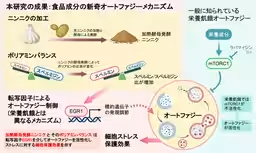

Unlocking the Secrets of Yeast-Fermented Garlic's Health Benefits
Understanding the Health Benefits of Yeast-Fermented Garlic
Recent research conducted by a team of scholars, including Waseda University's special research fellow Kuni Sha and professor Taisuke Hara, in collaboration with Nagasaki International University’s Professor Takuhiro Uto, has unveiled exciting findings regarding the health benefits of garlic that has undergone yeast fermentation.
The Mechanism Behind Cellular Health
The study highlights an invigorated mechanism through which yeast-fermented garlic amplifies the activation of autophagy, a crucial cellular maintenance process that helps to enhance the overall health of cells. Autophagy works to decompose and recycle cellular components, thereby preventing cellular aging and various diseases. However, this essential function tends to diminish with age, leading researchers to explore dietary components that can boost autophagy, thereby contributing to a healthier lifespan.
The research found that when garlic is fermented with yeast, not only does it increase autophagy activity compared to regular garlic, but it also optimizes the balance of two specific types of polyamines: spermidine and spermine. This balance is critical as it boosts autophagy through the transcription factor EGR1.
The Importance of Polyamine Balance
The substantial role of polyamines presents a breakthrough in understanding how balance, rather than mere quantity, plays an integral role in functional ingredients within dietary components. As polyamines are known for their presence in almost all tissues and their declining levels with age, the findings of this study suggest that consuming yeast-fermented garlic may be beneficial not only for activating autophagy but also for mitigating polyamine deficiencies that occur with aging.
Moreover, yeast-fermented garlic demonstrated protective effects against cellular stress and oxidative damage caused by the accumulation of abnormal proteins, linking it to potential preventative measures against neurodegenerative diseases like Alzheimer’s and various lifestyle-related illnesses.
Implications for Future Research and Health
The implications of this research extend to the broader nutritional landscape, offering evidence of the practical benefits derived from the foods we consume. The activation of autophagy via dietary sources could play a pivotal role in addressing increased abnormal protein loads due to aging, thereby providing a strategy for preventing numerous disorders. The newly proposed activation mechanism via EGR1 also adds a significant layer to our understanding, as it operates independent of conventional pathways linked to nutritional deprivation.
Given the safety levels associated with integrating functional ingredients into daily meals, this discovery underscores the potential for a proactive approach to health enhancement without the adverse effects often linked to dietary restrictions. Garlic, a long-regarded revitalizing food, can see its health impacts amplified through processing techniques such as fermentation and heating, allowing for greater health benefits.
This research also emphasizes the growing importance of understanding the functional dynamics of food components, particularly in the context of synergistic interactions between multiple ingredients. The meticulous attention to component ratios, particularly in foods like garlic, may yield deeper insights into dietary practices that could lead to improved public health outcomes.
Conclusion
The scientific exploration into yeast-fermented garlic stands as a beacon for future nutritional research. As the elderly population continues to grow, understanding how common foods can be optimized for health will be essential for combating age-related issues and fostering wellbeing. The pursuit of knowledge in this area promises to pave the way for nutritious innovations that may significantly bolster overall health and longevity.
Researchers encourage further exploration into how dietary choices can facilitate autophagy and contribute to health improvement strategies tailored for aging populations. The findings not only cater to academic inquiry but carry significant social implications for enhancing health and lifestyle quality in an increasingly aging society.
These promising results were published online on February 13, 2025, in the journal Molecular Nutrition & Food Research, under the title, 'The Yeast-Fermented Garlic and a Spermine/Spermidine Activates Autophagy via EGR1 Transcriptional Factor.' More about the study and its findings can be accessed here.

Topics Health)










【About Using Articles】
You can freely use the title and article content by linking to the page where the article is posted.
※ Images cannot be used.
【About Links】
Links are free to use.